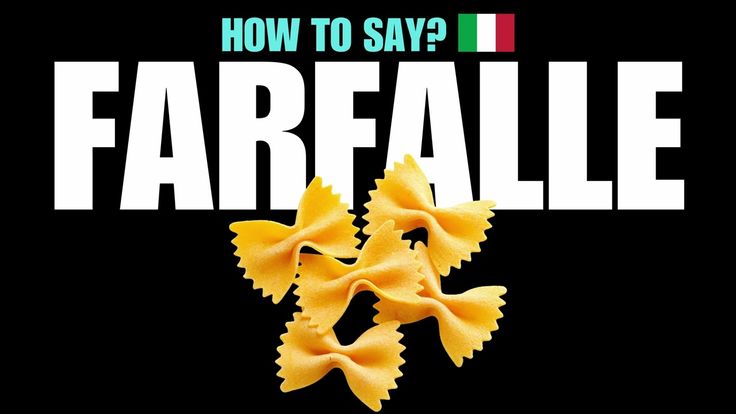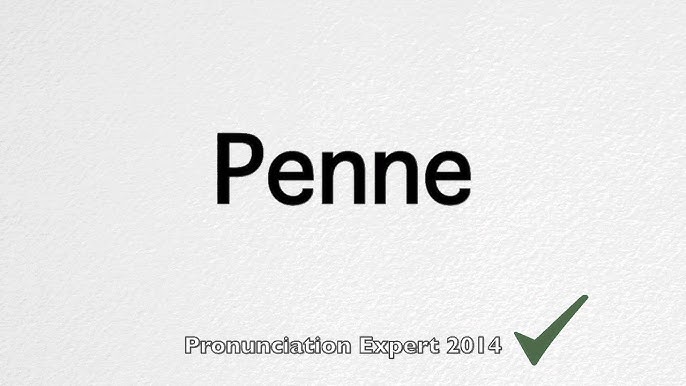Introduction To Italian Pasta Pronunciation

Italian cuisine is renowned for its delicious pasta dishes, and mastering the pronunciation of Italian pasta names is key to fully appreciate and immerse oneself in this culinary tradition. The way we pronounce these pasta names can greatly impact our dining experience and communication with others. In this section, we will explore the importance of pronunciation in Italian cuisine, common mispronunciations to avoid, and provide tips and exercises to help you master the basics of Italian pronunciation. So, let’s dive in and discover the world of Italian pasta pronunciation!
Pronunciation Importance In Italian Cuisine
Pronunciation plays a crucial role in Italian cuisine. Properly pronouncing Italian pasta names is not only a mark of respect for the language and culture but also ensures effective communication when ordering or discussing pasta dishes. It allows individuals to accurately convey their preferences and understand the ingredients and preparation methods. When dining at Italian restaurants or interacting with Italians, correctly pronouncing pasta names shows a genuine appreciation for the cuisine and promotes a more authentic dining experience. Mastering pasta pronunciation enhances one’s overall understanding and enjoyment of Italian gastronomy.
Common Mispronunciations Of Italian Pasta Names
Common mispronunciations of Italian pasta names often stem from misinterpretations of spelling or unfamiliarity with Italian pronunciation rules. One common mistake is mispronouncing “penne” as “peen” or “penny” instead of the correct pronunciation, “pen-neh”. Another frequently mispronounced pasta name is “gnocchi”, which is often pronounced as “ga-noh-kai” instead of the correct pronunciation, “nyoh-kee”. These mispronunciations can lead to confusion and hinder effective communication when ordering or discussing pasta dishes. It is important to familiarize oneself with the correct pronunciation of Italian pasta names to ensure a more authentic dining experience.
Mastering The Basics Of Italian Pronunciation

Mastering the basics of Italian pronunciation is essential for properly pronouncing Italian words, including pasta names. Understanding the specific sounds of Italian vowels and consonants is crucial. Italian vowels are generally pure and pronounced clearly, while consonants have specific rules for pronunciation. Additionally, it is important to familiarize oneself with stress patterns and accents in Italian words. To truly master Italian pronunciation, consistent practice and exposure to native speakers are key. By honing these basics, individuals can confidently pronounce Italian pasta names and fully appreciate the rich flavors of Italian cuisine.
Understanding Italian Vowels And Consonants
Understanding Italian vowels and consonants is crucial for mastering the pronunciation of Italian pasta names. Italian vowels are generally pure and pronounced clearly. There are five main vowels in Italian: A, E, I, O, and U. Each vowel has a consistent pronunciation. Italian consonants also have specific rules for pronunciation. For example, the letter “C” is pronounced as a hard “K” sound before the vowels A, O, and U, but as a soft “CH” sound before the vowels E and I. By familiarizing oneself with the specific sounds of Italian vowels and consonants, individuals can confidently pronounce Italian pasta names with accuracy.
Tips For Mastering Italian Pronunciation
Tips for mastering Italian pronunciation:
- Listen to native speakers: Immerse yourself in the sounds of Italian by listening to native speakers. This will help you familiarize yourself with the correct pronunciation and intonation of Italian words.
- Practice with guidance: Use pronunciation guides or language learning apps that provide audio exercises. These resources can help you practice the correct pronunciation of Italian sounds and words.
- Repeat and imitate: Practice saying Italian words out loud, focusing on the specific sounds and intonation. Repeat them multiple times to improve your muscle memory and fluency.
- Pay attention to vowel sounds: Italian vowels have consistent and clear pronunciation. Listen carefully to the differences in vowel sounds and practice pronouncing them accurately.
- Seek feedback: Record yourself speaking Italian and compare it to native speakers. Take note of any areas where your pronunciation may need improvement and seek guidance from language experts or native speakers.
- Practice regularly: Consistency is key when it comes to mastering pronunciation. Set aside dedicated time each day to practice speaking Italian and focus on improving your pronunciation skills.
By following these tips and dedicating yourself to regular practice, you’ll be well on your way to mastering Italian pronunciation.
Pronouncing Penne Correctly

Pronouncing Penne correctly is essential for any pasta enthusiast. To master the pronunciation of Penne, break it down into sounds: “PAST” + “UH.” It is important to emphasize the “a” sound in “PAST” and the short “u” sound in “UH.” Practice saying the word out loud, exaggerating the sounds until you can consistently produce them. To further refine your pronunciation, consider recording yourself and evaluating your progress. By mastering the correct pronunciation of Penne, you can confidently order and discuss this popular Italian pasta dish.
Breakdown Of The Pronunciation Of Penne
The pronunciation of Penne can be broken down into two syllables: “pen” and “neh.” Emphasize the “a” sound in “pen” and the short “e” sound in “neh.” It is important to note that the double “n” in Penne should be pronounced as a single sound, similar to the “ny” sound in “canyon.” Avoid pronouncing it as “pen-nee” or “peen.” By understanding the breakdown of the pronunciation, you can confidently pronounce Penne and appreciate its deliciousness in Italian cuisine.
Practice Exercises For Perfecting The Pronunciation
To perfect the pronunciation of Italian pasta names like Penne, practice exercises can be helpful. One effective exercise is to repeat the name of the pasta multiple times, focusing on each syllable and the correct pronunciation. Another exercise is to listen to audio recordings or videos that demonstrate the proper pronunciation of Penne and other Italian pasta names. By imitating the pronunciation and practicing along with the recordings, you can train your ears and mouth to produce the correct sounds. Consistency and repetition are key to mastering the pronunciation of Penne and other Italian pasta names.
Italian Pasta Pronunciation Etiquette

When it comes to pronouncing Italian pasta names, it’s important to be mindful of Italian pasta pronunciation etiquette. Italians take pride in their culinary traditions and appreciate when their language is spoken correctly. To show respect, it’s best to make an effort to pronounce Italian pasta names accurately. This includes pronouncing each syllable clearly and using the appropriate stress on the vowels. Additionally, it’s important to avoid anglicized or Americanized pronunciations. By adhering to Italian pasta pronunciation etiquette, you not only display cultural sensitivity but also enhance your appreciation for the rich Italian culinary heritage.
Respecting Cultural Norms When Pronouncing Italian Pasta Names
Respecting cultural norms is an essential aspect of pronouncing Italian pasta names correctly. Italians take great pride in their culinary traditions, and correctly pronouncing pasta names is seen as a sign of respect for their language and culture. By making an effort to pronounce each syllable clearly and using the appropriate stress on the vowels, you show your appreciation for the rich heritage of Italian cuisine. It is important to avoid anglicized or Americanized pronunciations, as this can be perceived as disrespectful. By adhering to Italian pasta pronunciation etiquette, you demonstrate cultural sensitivity and enhance your overall dining experience.
Common Mistakes To Avoid In Italian Pronunciation
When it comes to pronouncing Italian pasta names, there are a few common mistakes that should be avoided. One major mistake is misplacing the stress on the vowels. Each Italian word has a specific stress pattern, and mispronouncing the stress can completely change the meaning of the word. For example, pronouncing “penne” with the stress on the first syllable instead of the second syllable can lead to confusion. Another mistake is not pronouncing each syllable clearly. Italian words are known for their syllable-based pronunciation, so it’s important to give each syllable its proper emphasis. Finally, using an anglicized or Americanized pronunciation can be seen as disrespectful to the Italian language and culture. It’s important to make an effort to pronounce the words in their authentic Italian form. By avoiding these common mistakes, you’ll enhance your ability to communicate while showing respect for the Italian language.
Beyond Penne: Pronouncing Other Italian Pasta Names

When it comes to Italian cuisine, there are many other pasta names that can be tricky to pronounce. From spaghetti to fusilli, each pasta has its own unique pronunciation. To help master the art of pronouncing these names, it’s important to break them down into their individual sounds. Practice saying each syllable clearly and emphasize the correct stress patterns. Don’t be afraid to ask for guidance or listen to audio examples for reference. With practice and patience, you’ll be able to confidently pronounce a variety of Italian pasta names and impress your fellow food lovers.
Guidance On Pronouncing Popular Italian Pasta Names
When it comes to pronouncing popular Italian pasta names, it’s essential to break down the words into syllables and practice saying them aloud. Here are some tips to help you:
- Listen to native Italian speakers or audio examples to familiarize yourself with the correct pronunciation.
- Pay attention to the stress patterns and accents in the words.
- Emphasize the correct vowel and consonant sounds in each syllable.
- Practice saying the names slowly and gradually increase your speed as you become more confident.
- Don’t be afraid to ask for guidance or clarification if you’re unsure.
By following these tips and practicing regularly, you’ll be able to confidently pronounce popular Italian pasta names and impress your dining companions.
Audio Examples For Practice And Reference
To further assist in perfecting your Italian pasta pronunciation, audio examples can be a valuable tool. Listening to native Italian speakers pronounce popular pasta names can help you understand the correct intonation and stress patterns. Online resources, language learning apps, and even YouTube videos can provide audio examples for practice and reference. By actively listening and imitating the pronunciation, you can enhance your own spoken skills and gain confidence in pronouncing Italian pasta names accurately. Remember, practice makes perfect, so take advantage of these audio resources to refine your pronunciation.
Conclusion

In conclusion, mastering Italian pasta pronunciation is a valuable skill for any pasta enthusiast. By correctly pronouncing pasta names like “penne,” individuals can enhance their dining experience and engage in meaningful conversations about their favorite pasta dishes. It is important to respect Italian culture and language by learning and practicing proper pronunciation. With dedication and the use of resources, such as audio examples and practice exercises, one can improve their skills and confidently navigate the world of Italian cuisine. So, let’s continue practicing and exploring the delicious world of pasta!
Summary Of Key Pronunciation Tips For Mastering Italian Pasta Names
Mastering the pronunciation of Italian pasta names can be a valuable skill for any pasta enthusiast. Here are some key tips to help you pronounce Italian pasta names correctly:
- Understand Italian vowels and consonants: Familiarize yourself with the unique sounds of Italian vowels and consonants, as they may differ from those in English.
- Break down the word: Divide the pasta name into syllables and pronounce each syllable separately to ensure you are pronouncing each sound accurately.
- Listen to native speakers: Immerse yourself in the language by listening to recordings or watching tutorials of native Italian speakers pronouncing pasta names.
- Practice and record yourself: Regular practice and self-evaluation can help refine your pronunciation skills. Consider recording yourself to compare your pronunciation with that of native speakers.
Remember, respecting Italian culture and language by correctly pronouncing pasta names will enhance your dining experience and allow for engaging conversations about your favorite pasta dishes.
Encouragement To Continue Practicing And Exploring Italian Cuisine
Continuing to practice and explore Italian cuisine is an exciting and rewarding journey. As you perfect the pronunciation of Italian pasta names, you’ll deepen your understanding and appreciation for the rich culinary traditions of Italy. Don’t be discouraged by initial challenges—every effort you make to master the pronunciation will enhance your dining experience and allow for engaging conversations about your favorite pasta dishes. So keep practicing, immerse yourself in Italian culture, and savor the opportunity to delve deeper into the world of Italian cuisine. Buon appetito!
FAQ About How To Say Penne: Mastering Italian Pasta Pronunciation
Q: What is the correct pronunciation of “penne”?
A: The correct pronunciation of “penne” is pen-eh, with the stress on the second syllable.
Q: Is “penne” pronounced like “penny” in English?
A: No, “penne” is pronounced differently from “penny.” The Italian pronunciation is pen-eh, while “penny” is pronounced as pen-nee in English.
Q: How can I improve my Italian pasta pronunciation?
A: To improve your Italian pasta pronunciation, you can listen to native speakers, practice pronouncing different pasta names, and pay attention to vowel sounds and stress patterns in Italian words.
Q: Are there any resources available to help with Italian pronunciation?
A: Yes, there are various online resources, language apps, and pronunciation guides that can help you with Italian pronunciation, including specific guides for pasta names like “penne.”
Q: What are some common mistakes people make when pronouncing “penne”?
A: Some common mistakes include pronouncing it as “pen” instead of “pen-eh,” stressing the first syllable instead of the second, or confusing it with the English word “pen.”
Q: Can you provide an example sentence using “penne” in the correct pronunciation?
A: Sure! An example sentence would be: “I ordered a delicious dish of penne arrabbiata for dinner.” Remember to pronounce “penne” as pen-eh in this context.
